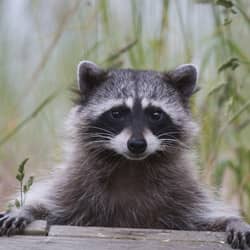What To Do When The Wildlife Show Up
October 24, 2014

In: Wildlife
What is cuter than watching a couple of squirrels chasing each other around your leaf-covered lawn, trying to wrestle the last of the acorns to hide away in their nests to keep them going through the cold winter? Everyone loves to stroll through the park and see all of nature's animals going about their business. Raccoons, rabbits, skunks and a variety of other creatures are left to their own devices when they live apart from humans.
As people encroach more and more into animal's domain, wildlife observed in nature can quickly turn into something more intrusive, like spotting a squirrel lodging in your attic! So, what's the deal? Why can't these fluff balls stay outside so we can all be happy? Well, as the weather gets colder, a good portion of these "outdoorsmen" will start to take a closer look at human habitats. Watch out! They'll be looking for an easy meal and a warm spot to spend the winter. Having a wild animal, no matter the size, in your home, in your attics or the crawl space under your home can be a potential danger to both your home's structure and to you and your family. Many of these animals will chew on wires, causing major electrical problems. They will also make nests in attics, garages, crawl spaces and chimneys. The larger animals ,such as raccoons, can cause damage to your roof or chimney, while they prepare for the winter.
Most wild animals have the potential to bite when they feel scared or threatened. With cases of rabies on the rise, extra caution should be taken around such wild animals. Raccoons are the largest potential carriers of this disease but skunks, foxes, and bats have also been known to be carriers. There is also a good chance that any of these creatures may be hosts to some tiny little hitch hikers like fleas and ticks that can also care a variety of diseases that are dangerous to humans.
The best way to make sure that your home doesn't become a menagerie to some unwanted woodland creatures is to make it a less attractive spot to spend their time in.
Here are some good ways to deter these pests:
-
Keep all trash bins well covered and removed frequently from your home and garage.
-
Any leaking faucets, pipes and outdoor spigots should be fixed and well maintained.
-
If you have fruit trees, make sure that you are disposing of what drops.
-
Be sure to bring in your bird feeders nightly and when they are on display, keep them well out of wild animals reach.
-
Also, keep your pet's food and water dishes indoors and feed them at specific times, opposed to leaving food out all day.
Now that you have removed the temptation of easy food for them, you should also make sure that you are not setting out the welcome mat for them to move in to your home. Animals are resourceful and can find a variety of ingenious ways to claim a bed in the house or garage. Make sure that you do not leave brush piles or leaves for a long period of time near your house and that firewood is at least 20 feet from the house. These are prime nesting spots. Also, keep tree limbs trimmed and away from your house or hanging over the roof to prevent easy access. Install Chimney caps and inspect your screens for damage. All ventilation areas should be well covered and replace mortar and weather stripping around your basement and doors.
If you find that you do have a wild animal in your home or that they have become a nuisance on your property, it is very important that you do not try to catch these pests yourself. Just because an animal doesn't look sick doesn't mean that they are not carriers of rabies. Call a pest professional to come take care of the animal. They have the means to do it quickly and safely. For more information on wildlife removal, give us a call!
For Immediate Assistance Call (888) 324-7025
 Subscribe to blog
Subscribe to blog
- Recent Blog Posts
- March 19, 2024 - What To Do If You Spot A Bee's Nest On Your Western Massachusetts Property
- March 17, 2024 - Is Professional Squirrel Control Necessary In Hartford?
- March 17, 2024 - Earwig Control Made Simple For Homeowners In Western Massachusetts
- Categories
- Ants - (25)
- Bed Bugs - (62)
- Birds - (10)
- Biting Insects - (7)
- careers - (1)
- Carpenter Ants - (5)
- Carpenter Bees - (6)
- Carpet Beetles - (12)
- Clover Mites - (7)
- Cockroaches - (30)
- Tags
- flea and tick prevention - (1)
- cockroaches in greenfield - (1)
- signs of cockroaches - (1)
- property inspection - (1)
- commercial bird control in ma and ct - (1)
- diseases from mice - (1)
- moisture problems - (1)
- western mass carpenter ants - (1)
- pest birds in connecticut - (1)
- zika virus - (1)
- View All Tags




